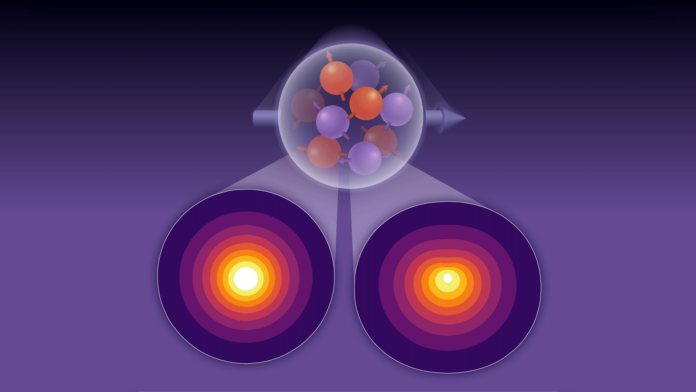Using supercomputers, a collaboration of nuclear theorists has predicted the spatial distributions of charges, momentum, and other properties of “up” and “down” quarks within protons. This is the first study to use a novel theoretical approach to create a high-resolution map of quarks within a proton.
Their calculations also showed that the up quark has a more symmetrical distribution and is scattered across a smaller area than the down quark. These variations suggest that up and down quarks may contribute differently to the fundamental features and structure of the proton, including its internal energy and spin.
Furthermore, calculations provide input for understanding data from nuclear physics experiments investigating how quarks and the gluons that keep them together are distributed throughout the proton, resulting in its overall properties.
The collaboration includes scientists from the U.S. Department of Energy’s (DOE) Brookhaven National Laboratory, Argonne National Laboratory, Temple University, Adam Mickiewicz University of Poland, and the University of Bonn, Germany.
The scatterings, in particular, provide scientists access to the proton’s Generalized Parton Distribution (GPD)—parton being the collective designation for quarks and gluons. If you imagine the proton as a bag packed with marbles representing quarks and gluons, the GPD describes how the energy-momentum and other properties of these marbles are distributed within the bag, such as when the bag is shaken, and the marbles move around.
It is analogous to a map that displays the possibility of discovering a marble with a specified energy momentum at a specific point within the bag. Knowing the distribution of these quark and gluon properties allows scientists to understand better the proton’s inner workings, which may lead to novel applications.
Obtaining a detailed map requires analyzing several scattering interactions involving several values of the proton’s momentum change. Scientists developed a novel theoretical approach to simulate the multiple momentum changes of the proton efficiently.
Shohini Bhattacharya, a research associate in Brookhaven’s nuclear theory group and the RIKEN BNL Research Center (RBRC), said, “Each momentum change value of the proton required a separate simulation, significantly increasing the computational burden to obtain a detailed proton map. The new method can look at the effect of the momentum transfer as all being on the outgoing proton—the final state. This gives a view that is closer to the actual physical process.”
“Most importantly, the new theoretical approach makes it possible to model numerous momentum transfer values within a single simulation.”
Quantum chromodynamics (QCD) describes the calculations that describe quarks and their interactions. However, these equations are extremely difficult to solve because they contain so many variables. A technique known as lattice QCD, developed at Brookhaven Lab, aids in overcoming the difficulty.
Physicists use this method to “place” quarks on a discretized 4D spacetime lattice—a sort of 3D grid with quarks at the nodes that accounts for how the arrangement of quarks varies over time (the fourth dimension). Supercomputers solve QCD equations by iterating over all of the conceivable interactions of each quark with all of the others, including how the many variables influence those interactions.
The novel approach for modeling photon interactions with protons allowed them to use lattice QCD to simulate a substantially higher number of momentum transfers, allowing them to obtain higher-resolution imaging around ten times faster than earlier efforts.
This method allows scientists to capture separate images of each quark type and calculate their GPDs.
Along with mapping out the energy-momentum distributions of the up and down quarks, the collaboration also mapped out their charge distributions within protons. They also looked at quarks’ momentum and charge distributions in polarized protons, which have their spins aligned in one direction, to see how the inner building blocks contribute to the proton’s spin. However, how this feature emerges from the proton’s basic building pieces remains a mystery.
Scientists discovered that the distribution of the momenta of the down quarks within a polarized proton is notably asymmetric and deformed compared to that of the up quarks. Because the spatial distribution of momentum reveals the angular momentum of quarks within a proton, these studies demonstrate that the differing contributions of up and down quarks to the proton’s spin result from their varied geographical distributions.
According to their calculations, up and down quarks can account for less than 70% of the overall spin of a proton. This means that gluons must also play a substantial role. The proton’s spin (angular momentum) distribution among its constituent quarks and gluons reveals information about the proton’s internal structure. This, in turn, aids scientists in their understanding of the forces at work within the atomic nucleus.
Experimental findings from Brookhaven Lab’s Relativistic Heavy Ion Collider (RHIC), a DOE Office of Science user facility at Brookhaven Lab, support the idea of a significant gluon contribution to spin. This is one of the central questions that will be explored in great detail at the future EIC.
Journal Reference:
- Shohini Bhattacharya, Krzysztof Cichy, Martha Constantinou, Xiang Gao, Andreas Metz, Joshua Miller, Swagato Mukherjee, Peter Petreczky, Fernanda Steffens, Yong Zhao. Moments of proton GPDs from the OPE of nonlocal quark bilinears up to NNLO. Physical Review D, 2023; 108 (1) DOI: 10.1103/PhysRevD.108.014507
